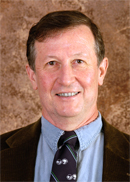Robert A. Armstrong
Ph.D., 1975, University of Minnesota
Email: Robert.armstrong@stonybrook.edu
Mathematical modeling in marine ecology and biogeochemistry
Research Interests
My specialty is mathematical modeling of biological and biogeochemical phenomena; the domain of my interests reaches from physiological ecology and biological community structure to biogeochemistry. These pieces are mutually supportive. I approach all these pieces, including biogeochemistry, from the standpoint of evolutionary ecology and optimal adaptation, since without this perspective biogeochemistry modeling often degenerates into mass budgeting. Conversely, I find biogeochemistry to be a rich and fascinating subject to which to bring an evolutionary ecological approach, an approach that a small but growing number of researchers are starting to take. I view modeling as a way to confront ideas with data: “Modeling is a process by which we take what we think we know about nature and cast it in quantitative form, so that we can confront it with data.”
In physiology, I have developed an optimality-based model for predicting phytoplankton chlorophyll:carbon ratios as functions of light and nitrogen (Armstrong, 2006). When entered in a NASA-sponsored round-robin competition among 30 models, my model did as well as any, and better than most, even though it was not “tuned” for that purpose (Friedrichs et al., 2009).
In community ecology, I developed a sophisticated model of phytoplankton-bacteria-microzooplankton interaction that can be used as the basis of many ecosystem models (Armstrong, 2003). A postdoc in my group, Markus Schartau, has just completed a groundbreaking analysis of IronEx II data (18 phytoplankton and 7 microzooplankton species) that will be used to exercise the capabilities of the Armstrong (2003) model. In addition, I propose to augment this model to include sarcodine grazers, then apply the resulting model to export and remineralization in the suboxic zone of the eastern tropical North Pacific.
In biogeochemistry, my major contribution has been the development of the “ballast ratio hypothesis,” (Armstrong et al., 2002, 2009), which posits that ratios of particulate organic carbon (POC) to “ballast” minerals (opal; the carbonate minerals calcite and aragonite; clays and other dust components) approach asymptotic values with depth. This hypothesis has sparked much new work in trying to relate the proportion of surface POC flux that reaches the deep ocean to POC:ballast ratios.
My goal in pursuing these objectives in tandem is to be able to bring their union to bear on problems that need a multi-scale approach. I invite and encourage students to broaden their intellectual horizons and capabilities as much as possible.
Most Relevant Publications
Schartau, M., M.R. Landry, and R.A. Armstrong. Non-parametric and parametric density estimation of plankton size spectra. Journal of Plankton Research (submitted).
Friedrichs, M.A.M., M-E. Carr, R.T. Barber, M. Scardi, D. Antoine, R.A. Armstrong, and 28 others, 2009. Assessing the uncertainties of model estimates of primary productivity in the tropical Pacific Ocean. Journal of Marine Systems 76, 113-133.
Armstrong, R.A., M.L. Peterson, C. Lee, and S.G. Wakeham, 2009. Settling velocity spectra and the ballast ratio hypothesis. Deep-Sea Research II 56, 1470-1478.
Armstrong, R.A., 2006. Optimality-based modeling of nitrogen allocation and photoacclimation in photosynthesis. Deep-Sea Research II 53, 513-531.
Armstrong, R.A., 2003. A hybrid spectral representation of phytoplankton growth and zooplankton response: the “control rod” model of plankton interaction. Deep-Sea Research II 50, 2895-2916.
Armstrong, R.A., C. Lee, J.I. Hedges, S. Honjo, and S.G. Wakeham, 2002. A new, mechanistic model for organic carbon fluxes in the ocean based on the quantitative association of POC with ballast minerals. Deep-Sea Research II 49, 219-236.
Bermuda Rise (BaRFlux)
Principal Investigators: David Black, Cindy Lee, Rob Armstrong and Kirk Cochran Funded by NSF Ocean Sciences Division Students Supported: TBA Project Description:The goal of this work is to achieve a better mechanistic understanding of the ocean’s role in the global...
Graduates Honored at MSRC’s 2005 Convocation Ceremony
Over 150 people crowded into MSRC' s conference room this morning - welcomed by MSRC 's Dean and Director David Conover - for a celebration honoring the 2005 graduates. In Conover's opening remarks, he highlighted the process of learning and emphasized that when...
Ocean Impacts on Global Climate Change
A site in the northeast Mediterranean Sea is providing MSRC researchers with new information about the ocean's role in the global carbon cycle. The MedFlux project - a large international collaborative effort including MSRC professors Cindy Lee, Kirk Cochran and Rob...
MedFlux
Principal Investigators: Cindy Lee, Rob Armstrong, Kirk Cochran and investigators from 6 other US and European institutions. Funded by NSF Ocean Sciences Division Students Supported: Gillian Stewart, Aaron Beck, Jennifer Szlosek, Zhanfei Liu, and Jianhong Xue (all...
OCTET Workshop Report
Acknowledgements We thank the National Science Foundation Division of OceanSciences, NOAA Office of Global Programs, and NASA Office of EarthScience for financial support for this workshop. We particularlythank Don Rice of the NSF Chemical Oceanography Program...



